|
Canon RF 24-240mm f/4-6.3 USM IS - Review / Test Report |
|
Lens Reviews -
Canon EOS (Full Format)
|
Review by Klaus Schroiff, published April 2023

Introduction
Reviewing a "super zoom" lens is both heaven and hell. It's heaven because the world is full of shooting opportunities with this much zoom range. And it's hell for the same reason when having to do the formal testing across many focal lengths in the lab - with results that are often not all that exciting. Anyway, these lenses are popular, so they are an "inevitable" part of the game. This time, it's about the Canon RF 24-240mm f/4-6.3 USM IS. Canon has a bit of a mixed history regarding super zoom lenses. There is, of course, the mighty EF 28-300mm f/3.5-5.6 USM L IS or its predecessor, the EF 35-350mm f/3.5-5.6 USL L - both loved and well respected within the photojournalist community. On the other hand, there was the miserable EF-S 18-200mm f/3.5-5-6 IS or the terrible EF 28-200mm f/3.5-5.6 USM. So let's see which category this new RF lens falls into. Given its rather steep price tag of a whopping $900/1000EUR, it better delivers something decent ...
 In terms of mechanical quality, there's nothing wrong with the RF 24-240mm f/4-6.3 USM IS. Yes, it's mostly made of plastics, but it feels quite sturdy. This - admittedly subjective impression - may also relate to the rather heavy weight of 750g. The lens doesn't feature any weather sealing, which is a bit meh, given its price tag. Typical for its class, it extends quite a bit when zooming toward the long end of the range - using 2 inner lens tubes.
Even so, our sample didn't exhibit any wobbling even when fully extended. You can feel the extreme zoom range when turning the zoom ring, but the zoom action is pretty good. The custom control ring, also used for focusing, operates smoothly as well.
The petal-shaped lens hood is optional. This is common practice with non-L Canon lenses, but for a penny article, it's disappointing nonetheless.
In terms of mechanical quality, there's nothing wrong with the RF 24-240mm f/4-6.3 USM IS. Yes, it's mostly made of plastics, but it feels quite sturdy. This - admittedly subjective impression - may also relate to the rather heavy weight of 750g. The lens doesn't feature any weather sealing, which is a bit meh, given its price tag. Typical for its class, it extends quite a bit when zooming toward the long end of the range - using 2 inner lens tubes.
Even so, our sample didn't exhibit any wobbling even when fully extended. You can feel the extreme zoom range when turning the zoom ring, but the zoom action is pretty good. The custom control ring, also used for focusing, operates smoothly as well.
The petal-shaped lens hood is optional. This is common practice with non-L Canon lenses, but for a penny article, it's disappointing nonetheless.
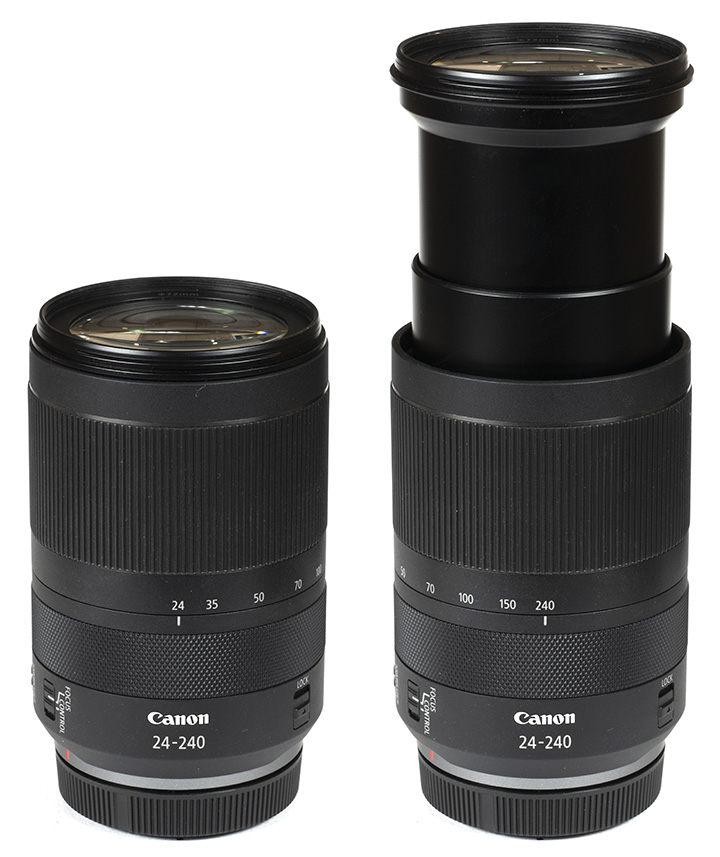 The Canon lens uses a Nano-USM for autofocusing - this is both very fast and noiseless. As usual, manual focusing works "by-wire" which works very well. The built-in image stabilizer is rated at 5 f-stops and is also optimized for smooth video stabilization ("Dynamic IS").
The Canon lens uses a Nano-USM for autofocusing - this is both very fast and noiseless. As usual, manual focusing works "by-wire" which works very well. The built-in image stabilizer is rated at 5 f-stops and is also optimized for smooth video stabilization ("Dynamic IS").
| Specifications |
|---|
| Optical construction | 21 elements in 15 groups (1 aspherical & 2x UD elements) |
| Number of aperture blades | 7 (rounded) |
| min. focus distance | 0.5-0.78m (max magnification: 1:3.8) |
| Dimensions | 80.4×122.5mm |
| Weight | 750g |
| Filter size | 72mm |
| Hood | petal-shaped (bayonet mount, optional) |
| Other features | control ring |
Distortion
As you might expect with such a lens, the RAW distortions aren't something Canon can brag about. The "worst" setting is, of course, at the wide end with an excessive barrel distortion of more than 8(!)%. At 50mm, we detected slight pincushion distortion, and this is amplified to strong pincushion distortions from the middle range all the way up to 240mm. So to sum this up - don't even think of using this lens without image auto-correction.
With activated auto-correction, these worries are mostly gone. At 24mm, you can still spot a mild barrel distortion just short of 1%. At medium to longer focal lengths, the distortions are basically eliminated, though.
Vignetting
The native vignetting characteristic is ... "interesting". At 24mm, the lens produces black corners regardless of the aperture setting. Or in other words - images are basically useless without auto-correction. The vignetting is "normal" at longer focal lengths.
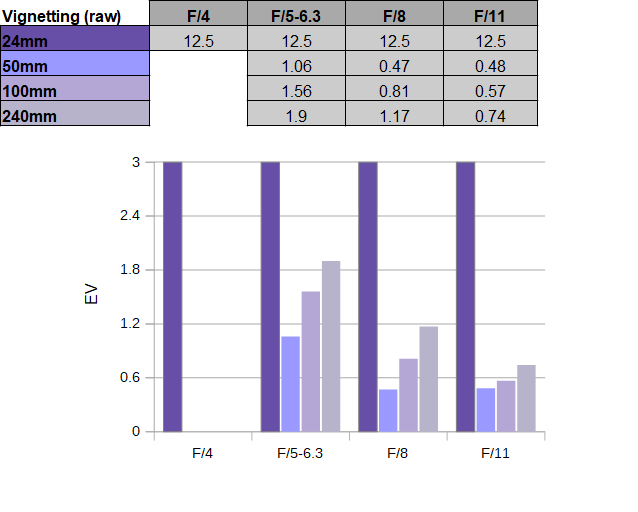 For the fun of it - the "vignetting" looks like this at 24mm:
For the fun of it - the "vignetting" looks like this at 24mm:
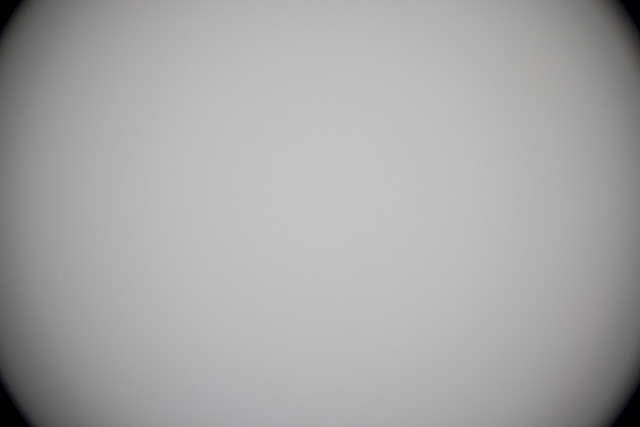 Once again, image auto-correction comes to the rescue. It reduces the fall-off with decent results at max aperture already and almost negligible vignetting when stopping down a bit.
Once again, image auto-correction comes to the rescue. It reduces the fall-off with decent results at max aperture already and almost negligible vignetting when stopping down a bit.
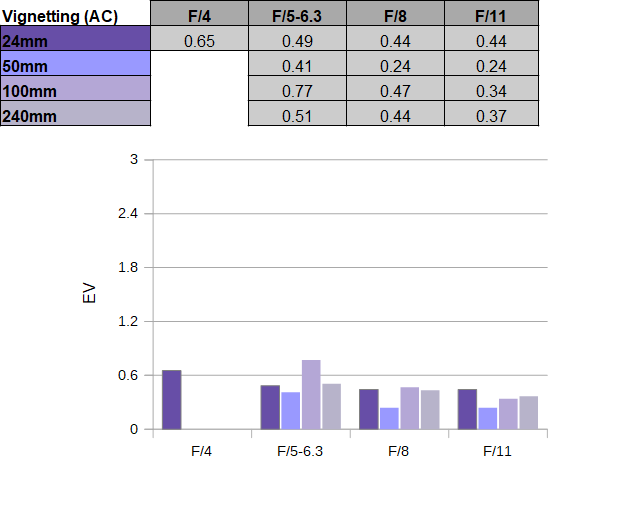
MTF (resolution at 45 megapixels)
An almost surprising aspect of the Canon RF 24-240mm f/4-6.3 USM IS is its resolution characteristic. Despite the 10x zoom ratio, it's actually pretty sharp. Its sweet spot (or better range) is the wide- to medium tele settings. Even the 24mm setting is quite decent despite the massive auto-correction at the setting. The center quality is excellent in the f/4 to f/8 range, and the border quality is still very good. The corners are somewhat softer but still very usable, even at f/4. Diffraction effects reduce the quality slightly at f/11. The quality is more even at 50mm and 100mm. The center quality is marginally reduced, whereas the corner performance improves quite a bit. Unsurprisingly, image quality takes a hit at 240mm. The broader center quality is still very good, whereas the outer image field gets softer without being terrible though. Stopping down to f/8 doesn't improve the image quality.
The field curvature is noticeable at 24mm but mild at the other tested focal lengths. The centering quality of the tested sample varied quite a bit - a typical fate in this class.
Please note that the MTF results are not directly comparable across the different systems!
Below is a simplified summary of the formal findings. The chart shows line widths per picture height (LW/PH) which can be taken as a measure of sharpness.
If you want to know more about the MTF50 figures, you may check out the corresponding Imatest Explanations

MTF (resolution at 30 megapixels)
If you are using a lower-megapixel body, the subjective quality perception will be "better" due to the lower pixel density. At 30 megapixels, the results are actually pretty impressive across the focal length range. This also applies to 240mm. Although it's not the last word in terms of sharpness, there's little to be desired here, even in the outer image field.

Chromatic Aberrations (CAs)
Lateral CAs (color shadows in the outer image field) are another weak spot in RAW images (only). At 24mm, the average CA pixel width is more than 3px on average at the borders and even more so in the image corner. The issue is a somewhat lesser concern other focal lengths, but, once again, Canon does solely rely on image auto-correction to handle this.

Bokeh
The RF 24-240mm f/4-6.3 USM IS can do many things for you, but it is hardly a lens that can be called a bokeh monster - it's just too slow for this. However, given its long tele range, you can still achieve some decent object isolation at closer focus distances.
Out-of-focus highlights are surprisingly clean, although there is a bit of an outlining effect that gets emphasized the more you stop down.
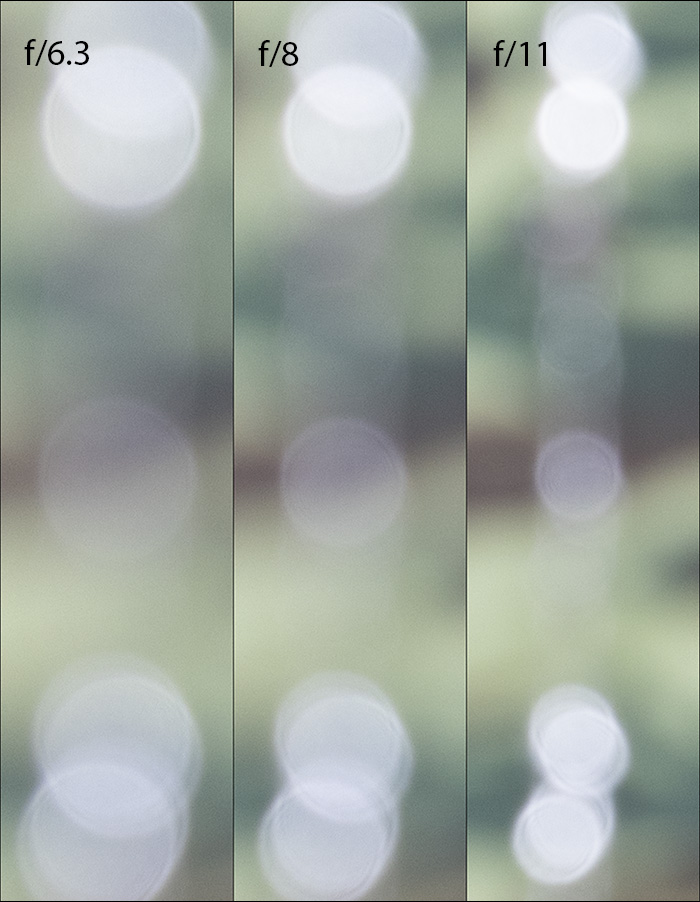 The shape of the highlights tends to deteriorate towards the image corners - this is due to mechanical vignetting. However, the shape deteriorates quite "late" towards the corners, as you can see below. Stopping down to f/8 restores most of the circular disc shape already.
The general image rendering in the focus transition zones isn't absolutely perfect, but it's still much better than expected. The blur is quite symmetrical and smooth both in the background (shown to the left below) and the foreground (to the right).
The shape of the highlights tends to deteriorate towards the image corners - this is due to mechanical vignetting. However, the shape deteriorates quite "late" towards the corners, as you can see below. Stopping down to f/8 restores most of the circular disc shape already.
The general image rendering in the focus transition zones isn't absolutely perfect, but it's still much better than expected. The blur is quite symmetrical and smooth both in the background (shown to the left below) and the foreground (to the right).
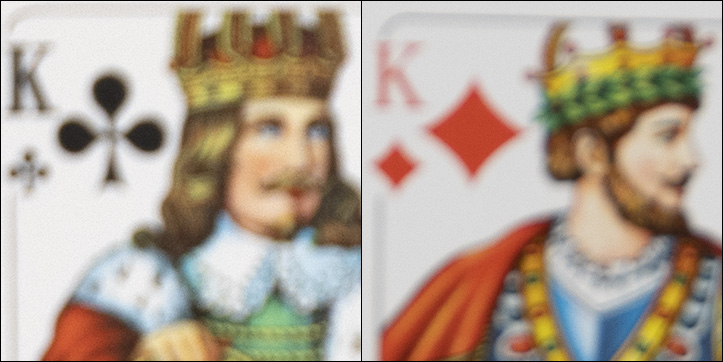
Sun Stars (Experimental)
Below is s sequence of 100% cropped images from 24mm f/4 all the way up to f/16 - illustrating the sun star behavior. Sun stars are an aperture effect that shows up if a bright light source is part of the scene (usually in night shots) - here, illustrated using an LED. While the lens is capable of producing star rays even at f/4, the shape isn't overly pleasant with "fan-like" rays plus sub-rays within.
Sample Images
Click on an image to download the full-size variant.
 |
| Make | Canon |
| Model | Canon EOS R5 |
| ISO Speed | 200 |
| Focal Length | 240.0mm |
| Aperture: | f/6.3 |
| Exposure | 1/400s |
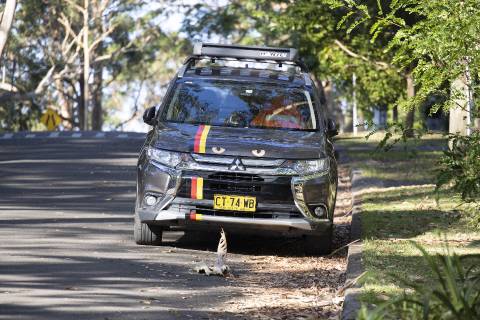 |
| Make | Canon |
| Model | Canon EOS R5 |
| ISO Speed | 200 |
| Focal Length | 240.0mm |
| Aperture: | f/6.3 |
| Exposure | 1/125s |
 |
| Make | Canon |
| Model | Canon EOS R5 |
| ISO Speed | 400 |
| Focal Length | 240.0mm |
| Aperture: | f/6.3 |
| Exposure | 1/60s |
 |
| Make | Canon |
| Model | Canon EOS R5 |
| ISO Speed | 200 |
| Focal Length | 240.0mm |
| Aperture: | f/6.3 |
| Exposure | 1/800s |
 |
| Make | Canon |
| Model | Canon EOS R5 |
| ISO Speed | 200 |
| Focal Length | 24.0mm |
| Aperture: | f/9.0 |
| Exposure | 1/500s |
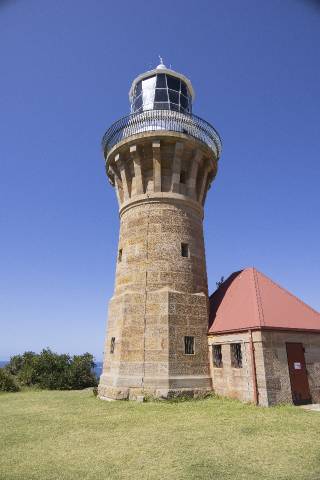 |
| Make | Canon |
| Model | Canon EOS R5 |
| ISO Speed | 200 |
| Focal Length | 24.0mm |
| Aperture: | f/9.0 |
| Exposure | 1/500s |
 |
| Make | Canon |
| Model | Canon EOS R5 |
| ISO Speed | 200 |
| Focal Length | 162.0mm |
| Aperture: | f/8.0 |
| Exposure | 1/640s |
 |
| Make | Canon |
| Model | Canon EOS R5 |
| ISO Speed | 200 |
| Focal Length | 58.0mm |
| Aperture: | f/9.0 |
| Exposure | 1/640s |
 |
| Make | Canon |
| Model | Canon EOS R5 |
| ISO Speed | 200 |
| Focal Length | 240.0mm |
| Aperture: | f/6.3 |
| Exposure | 1/160s |
 |
| Make | Canon |
| Model | Canon EOS R5 |
| ISO Speed | 200 |
| Focal Length | 129.0mm |
| Aperture: | f/6.3 |
| Exposure | 1/160s |
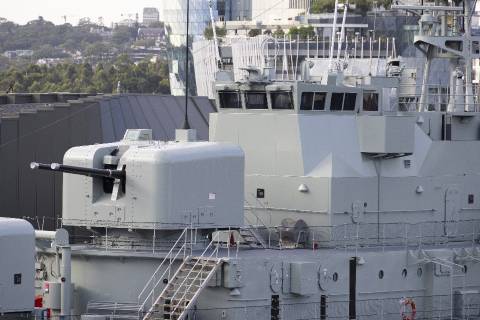 |
| Make | Canon |
| Model | Canon EOS R5 |
| ISO Speed | 200 |
| Focal Length | 240.0mm |
| Aperture: | f/9.0 |
| Exposure | 1/125s |
 |
| Make | Canon |
| Model | Canon EOS R5 |
| ISO Speed | 200 |
| Focal Length | 52.0mm |
| Aperture: | f/9.0 |
| Exposure | 1/200s |
 |
| Make | Canon |
| Model | Canon EOS R5 |
| ISO Speed | 200 |
| Focal Length | 79.0mm |
| Aperture: | f/8.0 |
| Exposure | 1/125s |
 |
| Make | Canon |
| Model | Canon EOS R5 |
| ISO Speed | 200 |
| Focal Length | 29.0mm |
| Aperture: | f/8.0 |
| Exposure | 1/200s |
 |
| Make | Canon |
| Model | Canon EOS R5 |
| ISO Speed | 200 |
| Focal Length | 24.0mm |
| Aperture: | f/8.0 |
| Exposure | 1/500s |
 |
| Make | Canon |
| Model | Canon EOS R5 |
| ISO Speed | 200 |
| Focal Length | 42.0mm |
| Aperture: | f/9.0 |
| Exposure | 1/200s |
Verdict
If we reviewed this lens during the early 2010s - thus before the era of image auto-correction - we'd have rated the Canon RF 24-240mm f/4-6.3 USM IS as ... trash. The resolution, distortion, and vignetting figures obtained from pure RAW files are all catastrophic at the wide end of the zoom range. However, this observation is a bit academic nowadays. This lens was certainly never meant to be used without image auto-correction, and this provides the framework in which we'll have to rate it. Fully corrected, the Canon RF 24-240mm f/4-6.3 USM IS can deliver very decent, maybe even surprisingly good, results. Typical for many lenses of this class, it achieves its best quality in the lower half of the zoom range. The resolution is decent at (the heavily corrected) 24mm setting with a very high center quality and a very respectable sharpness in the outer image field. There is a bit of field curvature, though. The quality is very even across the image field at 50mm and 100mm. Unsurprisingly the quality tanks a bit at 240mm. However, the critical center quality remains very usable, whereas the borders/corners suffer without being poor. If you are using a Canon camera with a 20-26mp sensor, the lens will be plenty sharp at all settings. A curiosity is the difference between 24mm images taken using JPEGs and RAWs (processed via Adobe ACR at least). Auto-corrected RAW files show a bigger field-of-view - which isn't ideal because the viewfinder shows the JPEG version. It's not a major issue but worth noting. The auto-correction didn't fully compensate for the extreme distortions at 24mm, but the remaining barrel distortion is mild and wouldn't bother you in most scenes. At other focal lengths, this is a non-issue. Auto-correction also does an excellent job with respect to vignetting - and that's also very much needed given the native characteristic. While the lens is certainly not aligned to shallow depth-of-field, the technical bokeh is actually pretty good. The same can't be said about sun stars, although let's be honest here - you can't have it all. The biggest optical issue may be a high risk of sub-par centering quality, which is a bit of a disease in this lens class for obvious reasons (the zoom ratio).
The build quality of the lens is surprisingly good. While it doesn't reach professional standards, it feels solid with no wobbling of the inner tubes to speak of, even when fully extended. The lens body is made of decent-quality plastic. One omission related to its target market is the lack of weather sealing. The AF is very snappy, and the image stabilizer is very efficient and dependable.
Given the fact that Canon RF is still a closed system at the time of this review, the Canon RF 24-240mm f/4-6.3 USM IS is the only available super zoom lens available in R-mount - and Canon lets you feel their strategy with its price tag. $1000 for a heavily "underdesigned" lens is quite a toad that you have to swallow. That being said - this isn't unheard of. The Sony FE 24-240mm f/3.5-6.3 OSS isn't any cheaper but quite a bit worse optically. However, in Sony land, you have at least an escape route with the pretty good and reasonably priced Tamron 28-200mm f/2.8-5.6 Di III RXD. Overall, we were positively surprised by the quality of the (auto-corrected) images, so we shouldn't complain too much about it.
Optical Quality (45 megapixel):
★★★★★
Optical Quality (30 megapixel):
★★★★★
Mechanical Quality:
★★★★★
What does this mean ?
|
|